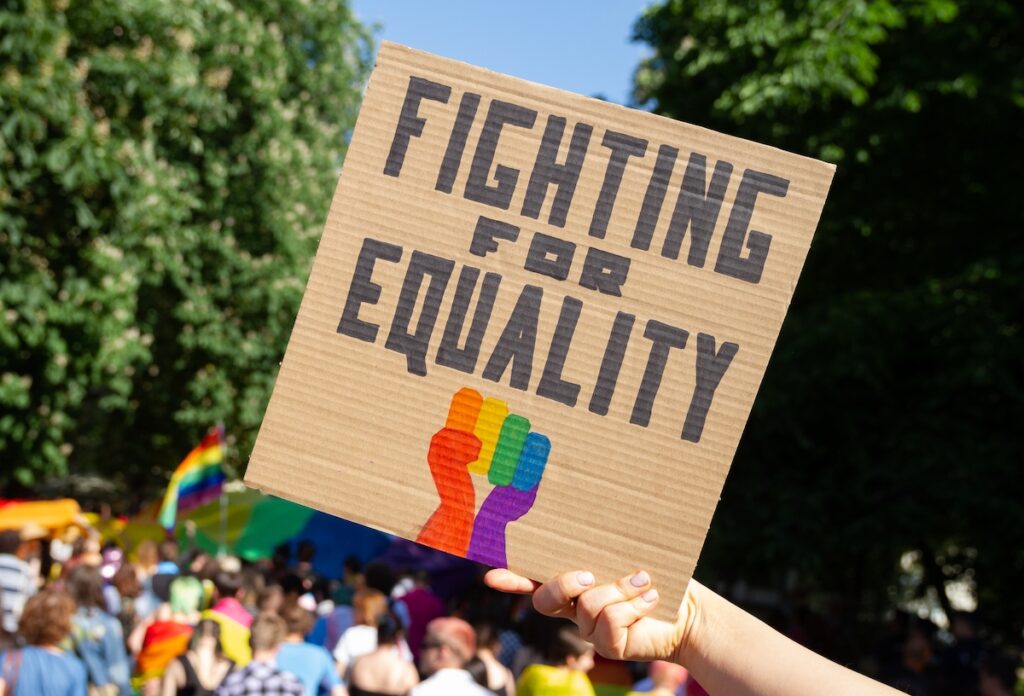New-Brown, Sargeant and Wright (2023) take us on a journey through the tumultuous landscapes navigated by psychologists working with gender diverse children and young people (CYP) in school settings. Critically, there is more than one landscape at play; much like “the upside down” in Stranger Things, landscapes are live, experienced, and intersected by variance.
Soon after this systematic review was published, new and controversial guidance was released by the previous UK government in April, for teachers working with gender diverse young people in schools. As I am writing this article, an action group named ‘Trans kids deserve better’ scaled the balcony of the NHS HQ in London adorned with a sign stating, “We are not pawns for your politics”. When access to healthcare or academia is obscured by politicising and guidance, power imbalances are widened and control from the hands of the community impacted can be confiscated (Scholz et al., 2021).
A person’s gender identity, or internal experience of gender can be broad and highly individualised, holding this in mind I will use the term “gender diverse” throughout this blog to describe an umbrella of experience outside of cisgender experiences.
Gender diverse CYP broadly experience poorer mental health outcomes than their cisgender peers, such as increased rates for suicidal thoughts, behaviours and self-harm, and often lack a trusted adult within a school setting to turn to (Rivaz-Koehl., et al, 2014; Stonewall, 2017). Several protective factors to attend to these risks exist including safe access to education, inclusive policies and language (as opposed to dominant heteronormative ones), systemic training of teachers and professional networks, positive relationships with trusted adults and peer support (Russell et al., 2014, Johns et al., 2018, Garbarino, 2012).
New-Brown, et al (2023), conducted a systematic review to capture the perspectives of psychologists working with gender diverse young people within school settings in the US, UK, Australia and Cyprus. This systematic review aimed to address the following objectives:
- To explore and identify the perspectives and experienced of school-based psychological professionals providing support to gender diverse CYP.
- To centre the voices of psychological professionals with relevant experience.
- To support future practice.
The authors identified four key analytical themes, by which our landscape becomes somewhat clearer, and the interaction between the psychologist and their own understanding of gender diversity feels more possible.

Gender diverse children and young people broadly experience poorer mental health outcomes than their cisgender peers.
Methods
A systematic review of five databases was completed with studies included based on the following criteria:
- Qualitative and primary research data were included
- Quantitative and non-primary research were excluded
- The voice of at least one school-based psychological professional with direct experience working with gender diverse CYP.
1,264 studies were initially identified by the systematic search strategy, this involved using the Population Concept Context (PCC) across 5 electronic databases (PsychInfo, CINAHL, ERIC, SCOPUS and PROQUEST). Of those, 685 were then identified through titles and abstracts by means of PRISMA with a focus on qualitative resources with independent reviewers to focus on experience, nuances and meanings. In total, 18 studies published between 2013-2022 were included in the review; 11 from the US, five from the UK, one from Australia and one from Cyprus. Across studies, 141 school-based psychological professionals voices were included in the sample. Roles such as school counsellors and psychologists, trainee and qualified educational psychologists were represented in this population. The 18 studies were quality appraised via CASP with the focus being on the quality and rigour of the studies.
The research question asked was “what are the perspectives and experiences of school-based psychological professionals providing support to gender diverse CYP?” The authors conducted Thematic Synthesis (TS), which favoured the inductive approach in this exploratory context and stage and NVivo software facilitated the analysis process.
Results
Four analytical themes and related subthemes were identified as follows:
- The environment I work in is key.
- Firstly, this review names the changing social contexts, awareness, and visibility, as well as a growing need for interventions and support offered to gender diverse populations.
- Secondly, the unfamiliar territory in which psychologists navigate based on a lack of broader clinical guidance through mixed training and messages from a broader governing system.
- Thirdly, in entering and witnessing the distress and poor broader mental health outcomes of gender diverse young people in hostile school-systems, psychologists considered their role to be active and systemic, in increasing inclusive language, visibility in policy and administration, to ethos changing and advocating for gender diverse CYP.
- How do I know what to do?
- In the absence of guidance which intersects with the theme above, psychologists found themselves acting from their values, views and belief systems. These values were social justice, inclusion and acceptance.
- Through this space there was a feedback loop around their own concept and construct of gender, further guiding therapeutic work and development.
- Knowledge was gained actively, through reading and learning about lived experience within the LGBTQ+ community, as well as independent study. By means of personal connection, psychologists were motivated to foster their knowledge, and empower themselves to step into an active role within a system.
- Psychologists reflected on the courage, confidence and strength developed by deconstructing gender for themselves, and developing their skills to better support gender diverse CYP.
- Broader psychology skills such as person-centred practices, interpersonal skills, re-framing, and systemic work through parents supported these psychologists.
- Advocacy is central to my work.
- By being open about their own LGBTQ+ identities, some psychologists stepped into a positive role model position. Developing a positive relationship with the LGBTQ+ community was a motivator for psychologists, allowing them to feed this into systems and internal training as they recognised a systemic change could not happen without involving other professional networks and key stakeholders.
- The importance of an individualised approach was acknowledged in addition to the sparsity of research, understanding and guidance across intersecting identities such as neurodiversity, race and many more.
- Psychologists drew on the knowledge and experience of gender diverse young people, holding their experience with respect and maintaining their voices in centre stage.
- The importance of de-stigmatising, validating and accepting the experience of gender diverse young people aided in the co-construction of safe and non-judgemental therapeutic spaces.
- I am fighting against barriers and systems.
- The lack of training provided in the context of LGBTQ+ and specifically, with support gender diverse young people served to maintain the fear of “getting it wrong”, subsequently feeding hesitancy and inaction. Under-identification of gender diverse CYP due to lack of awareness and training meant that support was not offered to CYP who needed it.
- The lack of training in graduate settings, a lack of research and subsequent evidence-base play a role in maintaining inaction. This led to disparities in knowledge, confidence, and capacity of psychologists to support gender diverse CYP. The need for continuity of training with the school system on gender diversity, in addition to the introduction of training in graduate programs felt critical.
- Political and religious contexts played a major role in barriers experienced by psychologists, particularly, in the context of parental, familial and school-based views.
- The prevalence of transphobia and bullying was named by psychologists from binarised perspectives which systems needed to but did not want to address.
- A further barrier was that the topic of gender diversity was off limits entirely, and should not be talking about, psychologists were then positioned to risk complaints and self-marginalisation by attempting to push through.

Barriers such as patriarchal and conservative climates led to fear of negative personal outcomes, such as losing employment, leading psychologists to feel stuck.
Conclusions
This qualitative systematic review concluded that the four identified themes, while intersecting, often left psychologists mapping their own ways in a school-system by means of commonly held psychology-based values. The political, social, and cultural contexts for each school could present as a barrier or protective factor for moving towards an inclusive and safer schooling experience. While not all gender diverse CYP require psychological support, a positive adult relationship in school that could then activate and feed into further positive relationships felt central to psychologist’s work.
In the absence of guidance and parity of training and knowledge, psychologists sought to develop knowledge of and to connect with the gender diverse community. This could lead to effective advocacy work while centring the CYPs experience in the system, leading to further shifting. Conversely, this broader disparity of knowledge and experience may continue to grow, leading to mixed experiences for gender diverse CYP of psychological interventions when sought. This could be addressed by including gender diversity training in graduate programs to resource the next generation of psychologists.

Positive adult relationships or role models when sharing gender identity felt central to psychologist’s clinical practice.
Strengths and limitations
This systematic review robustly synthesised the qualitative research and identified important themes regarding psychologists’ experience of working with gender diverse CYP in schools that are pertinent to improving care and informing the field. There were clear objectives and well defined research question for a complex systematic search, the review was very readable with considered and inclusive language. It covered many unique vulnerabilities that the gender diverse population can experience while tapering that into a deeply complex and contextual network of intertwining systems, families, school, staff and other professionals. The aim of centring psychologists with direct experience was held to closely, detailing the interpersonal skills and connection across intersectional lines required to build upon with further knowledge and development. Naming the time constraints placed upon psychologists as a barrier for self-development in knowledge as well as prospective marginalisation of the psychologist when working within a system led by patriarchal or conservative positioning.
The seeking to silence psychologists through a “we don’t talk about Bruno” or “don’t ask don’t tell” ethos depicts the limitations experiences by many well-intentioned psychologists. In the same breath, acknowledging the paralysing fear around “getting it wrong”, a conversation that runs parallel to effective allyship felt imperative to note as this can block a system (Scholz et al., 2021).
Although the lack of research and knowledge around intersecting identities such as race, neurodiversity, culture and language with gender diversity was mentioned, further discussion around why could have been a meaningful discussion. Why is it that predominantly countries where the global minority are overrepresented, are predominantly English-speaking (with the exception of Cyprus) and considered High Income Countries (HICs), (Worldbank, 2024)? As depicted by the Amsterdam Rainbow Dress Project and the International Lesbian, Gay, Bisexual, Trans and Intersex Association (ILGA) in 68 countries it remains unsafe for LGBTQ+ people to live or visit, whist in 8 of these countries the punishment by law can reach the death penalty. There is also a question around why it is that these HICs lack research around working with gender diversity, when gender diverse people’s existence has predated Mesopotamia around 5000BC (Asher-Greve, 2002). Inequality of research funding between countries and among marginalised populations in combination with the lack of gender diversity in graduate training can lead to discussions similar to the chicken or the egg, thus inaction.
The authors carefully and conscientiously mapped an array of qualitative themes as interwoven and intersecting for psychologists with experience working with gender diverse young people. Clinical experience felt critical in controlling for speculation and second hand above primary experience. It may be that expanding beyond the five databases searches could have yielded a larger qualitative experiential base to build upon.

The lack of robust research on supporting psychologically gender diverse people in high income countries is questionable.
Implications for practice
This systemic review speaks to the role of power and control within systems that directly interact with gender diverse CYP. As a queer-identifying clinician who has often juggled the hats of ‘the educator’ and ‘the experiencer’, I value the clarity and coherent nature in which this review outlined such complex, contextual, and nuanced systems. Research like this, offers the unique view of a field through a lived experience lens, while also capturing themes that often go unspoken. There is often an emotional toll that accompanies holding both hats, where gender diverse clinicians working within school systems may have their voices held at the centre of research. I often think about the seesaw metaphor of amplifying queer clinical voices, while also freeing them of the responsibility of being “educator” all of the time.
The four themes, speak to the parallel journey of allyship taken by psychologists willing to prioritise their values, connection to a community and developing knowledge through independent learning. Independent learning can free the ‘experiencer’ from the role of ‘educator’, thus allowing for introspection and de-construction of gender as an experience as opposed to a fixed binary state.
Another clinical implication of this study is highlighting the additional hat of advocacy and of working systemically. Particularly working within CAMHS services, I have come to understand advocacy as part of what psychological professionals must to in order to create change. This study named that it is possible in a number of circumstances for the psychological professional to create the change within the system required to remove the barriers gender diverse CYP can experience in simply accessing education. Critically, naming that the meaningfulness of a CYPs education can be contingent on the views of educators and schools. If we connect this implication with the government consultation around personal, social, health and economic (PSHE) topics and school guidance with gender diverse young people, we can quickly see how lack of knowledge can impact upon CYP mental health outcomes. When you cannot see yourself reflected within a system, be that PHSE or connection through a well-intention ally/psychological professional, the vulnerability of this community could skyrocket. While politics change, and this landscape moves, we must be the constants for young people, as we know that the opposite of connection is isolation.
Independent learning can be broad, it can take multiple forms from engaging with reading to formalised LGBTQ+ mental health training. While there are deficits in clinical training, reading outside of the box and extending into feminist and social constructionist voices such as Simone de Beauvoir feels critical. In addition to Dr Judith Butler’s theory around Gender Performativity, or Queering Psychotherapy for more diverse queer clinical voices around intersectionality. When being taught about gender diversity or intersectionality is rare, we have to start asking why. If you are going through clinical training within a system that speaks to experiences and views of majority white European, cisgender male voices, and you do not see yourself reflected, what actions can you take to amplify the voices of those being shouted out?
The need for training in graduate programs, within schools and with a view for continuity to maintain inclusivity, safety and reduce non-judgemental/stigmatising spaces felt vital. To name that not all gender diverse young people require psychological support, and locate the problem within the system, rather than the young person, captures the perspective of the landscape in which positive change can be built upon by psychologists.
Further reading
- Working with LGBTQ+ young people in CAMHS – a clinical resource co-created with young people and CAMHS clinicians to address some of the challenges when supporting psychologically gender and sex diverse young people.

Educational training to maintain inclusivity, safety and non-stigmatisation for gender diverse young people is vital.
Statement of interests
Vanessa is an incoming trainee clinical psychologist and former CAMHS clinician. No competing interests.
Links
Primary paper
New-Brown, G., Sargeant, C., & Wright, S. (2023). Navigating the landscape: Roles, perspectives, and experiences of psychologists supporting gender diverse children and young people in school settings. International Journal of Transgender Health, 25(1), 102–122.
Other references
Asher-Greve, J.M. (1997), The Essential Body: Mesopotamian Conceptions of the Gendered Body. Gender & History, 9: 432-461.
Scholz, B., Gordon, S. E., & Treharne, G. J. (2021). Special issue introduction – working towards allyship: acknowledging and redressing power imbalances in psychology. Qualitative Research in Psychology, 18(4), 451–458.







